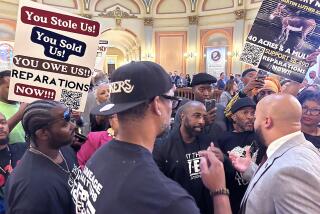So long, slavery reparations
Just a few years ago, at roughly the turn of the millennium, slavery reparations seemed the coming thing. A New York Times article in June 2001 reported that the movement to obtain compensation for slaves’ descendants had “taken on substantial force” and was “gaining steam” both in the nation’s universities and in the black community.
All the major black organizations had signed on, including the NAACP, the Urban League and the Southern Christian Leadership Conference. Randall Robinson’s book, “The Debt: What America Owes to Blacks,” had hit the bestseller lists in 2000. Many state and local Democratic politicians started to talk up the idea.
Then: nothing. Today, reparations seem to have completely disappeared from the national agenda. Few mention them anymore. What happened?
The idea of reparations for blacks had briefly come up at the time of the Civil War and the Emancipation Proclamation, but then was largely forgotten until 1969, when black militants, led by James Forman, began demanding a down payment of $500 million on future reparations. The brouhaha inspired liberal Yale law professor Boris Bittker to write “The Case for Black Reparations,” a book that appeared in 1973 and remains well worth a look 35 years later.
Bittker examined closely, but in the end dismissed as unpromising, the idea of filing lawsuits over blacks’ past maltreatment. For Bittker, it made sense to pursue reparations not through litigation but through legislation funded from government revenues. And in the years that followed, the U.S. did just that, in a way, by vastly increasing spending on social welfare, education, housing and urban programs, aimed primarily at relieving black poverty, as well as taking explicitly compensatory and race-based steps in the schools and workplace -- though these were not specifically designated as reparations.
The movement reemerged in the late 1980s. This time, its advocates came mostly from law schools and embraced what Bittker had once ruled out: lawsuits against private parties. They sought to establish links between slavery and private actors not widely regarded as tainted by it -- the more respectable, forward-minded and non-Southern these institutions, the better.
Thus it came to light that some New England insurance companies in antebellum days had collected premiums from slaveholders for policies written on slaves’ lives, and elite universities such as Harvard and Brown had received major financial benefactions from slaveholders and traders. As revelations of this kind emerged, a number of businesses and universities issued apologies or pledged increased donations to black causes.
In late 2000, a new project called the Reparations Assessment Group began making preparations for lawsuits. The dollar sums mentioned were staggering. Harper’s magazine estimated that it could require $97 trillion to pay for the hours of uncompensated work done during the slavery era, which would require extracting, on average, about $300,000 from every American of non-slave descent. So confident were reparationists of success that they began to map out how the court-ordered funds would be spent.
The attacks of Sept. 11, 2001, broke this momentum with an abrupt jolt. It wasn’t just that for quite a few months thereafter Americans of all races preferred to discuss issues unrelated to reparations; it was also that some of the persistent themes that ran through those days, such as national unity, individual heroism, mutual dependence and the implications of mortality were at cross-purposes with the reparations narrative. According to LexisNexis, U.S. newspapers and wire services ran nearly 2,600 stories including the words “slavery” and “reparations” in the year leading up to 9/11. Since then, the yearly average has been less than 1,000.
But that was only part of what stopped the movement. The fact is, the hoped-for mobilization of public opinion had hit a wall. Editorialists and liberal churchmen aside, only a very small share of whites supported the idea -- 5% in one poll, 4% in another -- while those opposed routinely topped 90%. The polls made it clear too that a substantial sector of black opinion quietly opposed reparations as well -- and sometimes vocally, as when author Juan Williams slammed it as “a dangerous, evil idea [that could] take American race relations on a crash course.”
The issue did resurface briefly in the media in the spring of 2002, with the filing of a class-action reparations suit that demanded $1.4 trillion from eight major corporations, including Aetna, Bank of America and the railroad concern CSX. Reparations lawyer Deadria Farmer-Paellmann and another freelancer, Richard Barber, had filed it, reportedly having grown impatient with the failure of the Reparations Assessment Group to act.
As a legal matter, the reparations claims proved desperately weak.
Consider the seemingly precedential claims arising from atrocities in wartime Europe. These suits did have several crucial advantages over slavery claims, most obviously that they arose from mistreatment of persons still or recently alive. Yet they mostly went nowhere before actual judges.
In 2005, a federal judge tossed out the Farmer-Paellmann and related reparations suits, in a decision largely upheld by the U.S. 7th Circuit Court of Appeals the next year. For most newspapers, the suit’s dismissal was a back-pages story; everyone had moved on. To the extent the reparations movement had used its brief time onstage to encourage national introspection, Americans had reached a different conclusion from the one that the activists had hoped for -- a rough consensus, in fact, that whatever the right approach to the nation’s perennial problem of race relations might be, ventures into anger-mongering and random expropriation weren’t it.
More to Read
Sign up for our Book Club newsletter
Get the latest news, events and more from the Los Angeles Times Book Club, and help us get L.A. reading and talking.
You may occasionally receive promotional content from the Los Angeles Times.







